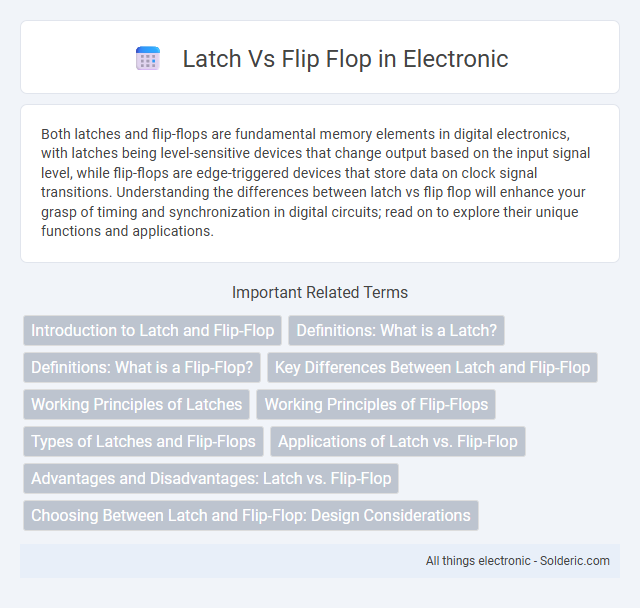Both latches and flip-flops are fundamental memory elements in digital electronics, with latches being level-sensitive devices that change output based on the input signal level, while flip-flops are edge-triggered devices that store data on clock signal transitions. Understanding the differences between latch vs flip flop will enhance your grasp of timing and synchronization in digital circuits; read on to explore their unique functions and applications.
Comparison Table
| Feature | Latch | Flip Flop |
|---|---|---|
| Definition | Level-triggered bistable device | Edge-triggered bistable device |
| Trigger Type | Level-sensitive | Edge-sensitive (rising/falling edge) |
| Control Signal | Enable signal (gate) | Clock signal |
| Output Change | Changes while enable is active | Changes only at clock edge |
| Usage | Temporary data storage, gating | Data storage and synchronization in sequential circuits |
| Complexity | Simple circuit design | More complex due to clocking |
| Noise Sensitivity | Higher, due to level triggering | Lower, controlled by clock edge |
| Examples | SR Latch, D Latch | D Flip Flop, JK Flip Flop |
Introduction to Latch and Flip-Flop
Latches and flip-flops are fundamental memory storage elements in digital circuits, with latches being level-sensitive devices that change output based on input signals as long as the enable signal is active. Flip-flops are edge-triggered devices that capture and store input data only on specific clock signal transitions, providing more precise timing control. The use of flip-flops over latches is crucial in synchronous circuits to ensure stability and avoid timing-related issues such as glitches.
Definitions: What is a Latch?
A latch is a basic memory device in digital electronics that stores one bit of data by maintaining its output state based on the input signals and a control signal, often referred to as the enable. Unlike flip flops, latches are level-sensitive devices which means they continuously monitor inputs and change output as long as the enable signal is active. Common types of latches include SR (Set-Reset) latch and D (Data) latch, both essential for asynchronous data storage and timing applications.
Definitions: What is a Flip-Flop?
A flip-flop is a bistable multivibrator circuit used to store a single bit of data, maintaining its output state until an input signal triggers a change. Unlike latches, flip-flops are edge-triggered devices, meaning they change states only at specific clock signal transitions, typically rising or falling edges. This clock dependency allows flip-flops to synchronize data storage and transfer in digital sequential circuits.
Key Differences Between Latch and Flip-Flop
Latches are level-sensitive devices that change their output based on input signals as long as the enable signal is active, whereas flip-flops are edge-triggered, updating their output only on specific clock edges (rising or falling). Latches are simpler and faster but prone to glitches, making flip-flops more reliable for synchronous circuits due to their precise timing control. Flip-flops typically consume more power and require a clock signal for operation, while latches operate without one, making them suitable for different design scenarios.
Working Principles of Latches
Latches operate as basic memory devices that store one bit of data through a feedback loop, maintaining their output state until the input changes. They are level-sensitive, allowing data to pass through when the enable signal is active, and retaining the state when the enable is inactive. This makes latches suitable for simple storage tasks but less ideal for synchronous circuits requiring precise timing control.
Working Principles of Flip-Flops
Flip-flops are bistable devices that store a single bit of data by maintaining a stable state until triggered by a clock signal, enabling synchronous data storage and transfer. Unlike latches, flip-flops change their output only on specific clock edges, ensuring precise timing control in digital circuits. Your designs benefit from flip-flops' edge-triggered operation, which prevents race conditions and improves circuit reliability.
Types of Latches and Flip-Flops
Latches include types such as SR (Set-Reset), D (Data), and JK latches, each characterized by level-triggered behavior that maintains output based on input signals. Flip-flops, in contrast, encompass SR, D, JK, and T (Toggle) flip-flops, which are edge-triggered devices capturing input data on clock signal transitions for precise timing control. These types differ primarily in triggering mechanisms and control inputs, influencing their applications in sequential logic circuits.
Applications of Latch vs. Flip-Flop
Latches are ideal for simple memory storage where data needs to be held temporarily, often used in asynchronous circuits and debounce circuits. Flip-flops play a critical role in synchronous systems, such as digital clocks, registers, and counters, where data changes are synchronized with clock signals. Your choice between a latch and a flip-flop depends on the requirement for timing control and data stability in your specific application.
Advantages and Disadvantages: Latch vs. Flip-Flop
Latches offer simplicity and faster operation due to their level-triggered nature, making them suitable for asynchronous circuits, but they are prone to glitches and timing hazards. Flip-flops, being edge-triggered, provide more reliable and stable data storage in synchronous circuits, minimizing timing issues but often require more power and complex design. Understanding the trade-offs between latch speed and flip-flop stability helps optimize Your circuit design effectively.
Choosing Between Latch and Flip-Flop: Design Considerations
Selecting between a latch and a flip-flop depends on timing requirements and signal stability in your digital design. Latches are level-triggered devices ideal for applications needing transparent data storage, while flip-flops are edge-triggered, offering better control over timing and minimizing race conditions. Your choice impacts synchronization, power consumption, and overall circuit reliability.
latch vs flip flop Infographic

 solderic.com
solderic.com